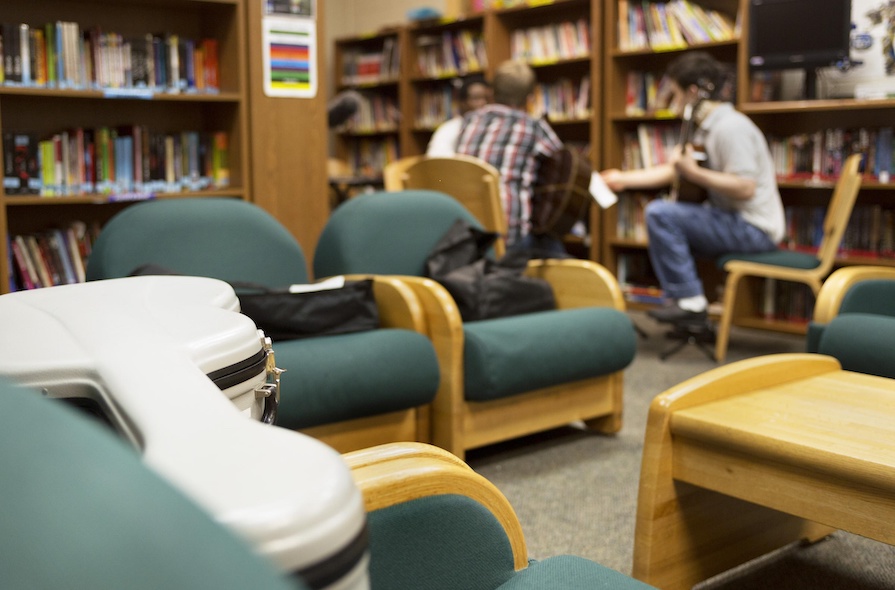For-Credit Arts Programs in Juvenile Justice

Youth practicing guitar in a library. Photo courtesy of Austin Classical Guitar.
In 2010, Austin Classical Guitar (ACG) expanded our 20-year school-based guitar education program to the Gardner Betts Juvenile Justice Center, a residential facility that houses a school within the Austin Independent School District (ISD)for middle and high school students. This for-credit arts program consists of direct instruction for students, teacher training and curriculum development. Since the inception of this program, ACG now serves three more juvenile justice facilities in Texas. We understand our role as working to connect deeply with young artists who are part of an unjust system that disproportionately punishes Black and brown youth, perpetuating a cycle that denies them opportunities.
How it began
Our partnership at Gardner Betts Juvenile Justice Center began when a social work professor and friend of ACG approached us about a possible collaboration. Dr. Cal Streeter was doing research at the Gardner Betts facility and was inspired by our work in the public school system. He knew that the student-centered, expressive approach we use would be a good fit for the students within the facility. Upon our first visit to the facility to meet with administrators, we learned that the only arts offering there was an online art appreciation survey course, and this was how the youth were getting their required Fine Arts credit. Our experience seeing this firsthand highlighted the discrepancy between the arts opportunities available for students in our typical middle and high schools and those for students in juvenile facilities. Leveraging our partnership with Austin ISD and the UT School of Social Work, we began offering daily classes to all students in the facility.
The Program
Each day, we meet with classes of guitarists at Gardner Betts, Williamson County Juvenile Justice Center, Phoenix House, and Dallas County Juvenile Justice Center. Students learn multiple styles and approaches to guitar by way of ensemble playing, solo pieces, improvisation, composition and songwriting. The focus of every class is musical and self-expression. From the very first day, students are asked to invest in the expressive capacity of each note they play, no matter how simple the musical task. We play together, we create together and we perform together. A 2015 PBS Newshour story highlights student perspectives on their experience in the class.
Why For-Credit?
The majority of ACG education programs are school partnerships embedded in the school day for many reasons. The primary reason is to ensure that all students have access to daily creative music opportunities where all involved have a vested interest and framework for successful group music learning. For us, this was a question of equity and access for all students. In this unique setting, a for-credit course can offer a greater level of support for the student than a non-credit enrichment program. Its integration with both academic and treatment services allows ACG to be a core part of the institution. And by offering a for-credit guitar course at Gardner Betts, we create a program that has the capacity to serve these young artists before, during, or after their time at the juvenile justice center because of our involvement with all area middle and high schools in Austin. Continued support is provided to our students as they transition back into the community by helping them to enroll in guitar class at their respective schools and giving individualized attention as they get back into daily life.
Starting a For-Credit Arts Program in a Juvenile Justice Center
Relationships: Create excitement around this dream within the education community. Build and leverage relationships with district administrators, fine arts directors, and school board members.
State Educational Standards: Choose, create, or adapt a curriculum that meets all state standards and be prepared to articulate this alignment to stakeholders.
Teacher Certification: Enlisting a certified arts educator to lead the for-credit program will make it easier to establish, but is not necessarily a requirement. In many cases, teaching artists without a formal teaching credential can direct the program with the sponsorship of a “teacher of record” from the facility to report grades and interface with administrators.
Funding: ACG’s programs are primarily funded by grants and individual donations. Any organization looking to provide this type of service should not expect compensation from the facility, though it’s always worth an ask. Often, the facility will cover the cost of materials and instruments but not cover staff time. Grant funding for this type of service is out there. Any organization’s biggest assets are the powerful stories of success that come out of these programs that will inspire and motivate any community to support.
To learn more about the programs and connect with ACG, visit our website or contact Travis.
This is the third post in the multi-part Juvenile Justice Series: Broadcasting Arts Experiences. AEP hopes these story-driven contributions will expand thoughtful discussion and research into the role of the arts in the juvenile justice system. You can read the first post in the series here and the second post in the series here.
If you’re interested in sharing your arts education experience in juvenile justice settings for a future blog post, AEP wants to hear from you! Please contact Project Manager Krystal Johnson.



